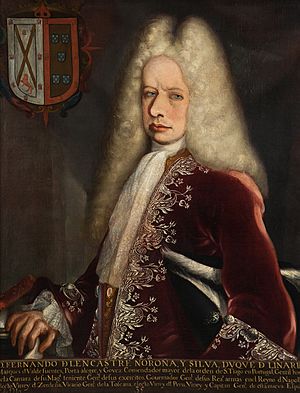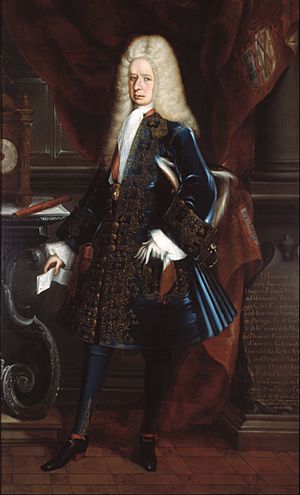Fernando de Alencastre, 1st Duke of Linares facts for kids
Quick facts for kids
The Most Excellent
The Duke of Linares
|
|
|---|---|

Portrait by Juan Rodríguez Juárez
|
|
| 35th Viceroy of New Spain | |
| In office November 13, 1710 – July 16, 1716 |
|
| Monarch | Philip V |
| Preceded by | The Duke of Alburquerque |
| Succeeded by | The Duke of Arión |
Fernando de Alencastre Noroña y Silva, 1st Duke of Linares (born April 15, 1662, in Madrid, Spain – died June 3, 1717, in Mexico City) was an important Spanish nobleman and military leader. He served as the Viceroy of New Spain (which was colonial Mexico) from January 15, 1711, to August 15, 1716.
Contents
Early Life and Career
Fernando de Alencastre came from a well-known Spanish family. His family had roots in the Portuguese nobility. Besides his inherited titles, he was a knight in the Order of Santiago. He also served as a trusted advisor to the king and a high-ranking army general.
Alencastre was an early supporter of the Jesuit missions in Baja California. He gave 5,000 reales (an old Spanish coin) in 1697 to help them get started.
Viceroy of New Spain
In 1711, Fernando de Alencastre became the colonial viceroy. This meant he was the king's main representative in the colony. He was also the captain general and president of the Audiencia Real, which was like the highest court.
Natural Disasters and Aid
On August 16, 1711, a very strong earthquake hit. It damaged many buildings and caused many deaths. People said the earthquake lasted for half an hour. The viceroy reportedly used his own money to help poor people. He also helped to fix some of the damaged buildings.
In 1713, Mexico City saw a snowfall unlike any before. This led to a bad harvest and a severe famine. Many people were on the streets, begging for food. A serious plague then broke out, lasting into the next year. Many sick people were left on the streets. Many died and were buried in shared graves. Both the viceroy and the archbishop of Mexico, José Lanziego, used their own money to help the poor during these hard times.
Strengthening Defenses
Viceroy Alencastre worked to make New Spain safer. He ordered four new, well-armed warships to be built at Coatzacoalcos. These ships were meant to strengthen the coast guard. He also bought 600 new muskets for the local army. He sent money to repair forts in Cumaná, a city in present-day Venezuela.
Trade and Economy
Around 1711, Alencastre suggested a new idea to the Council of the Indies in Spain. He wanted to allow private Spanish ships to trade between New Spain and Peru. These colonies were on the Pacific Ocean coast. Spain usually sent goods to Peru by government ships. These ships went to Portobelo in Panama, and then goods were moved overland to Lima. Direct trade between Spanish colonies was not allowed.
However, the Spanish government fleet often did not arrive. This was because of the War of the Spanish Succession. French ships started sailing around South America to Peru. They sold European goods for silver. Then they sailed to Asia to trade silver for Asian products like textiles. They would return to Peru to sell these goods.
Viceroy Alencastre thought Spain should let its own merchants trade between Acapulco (in New Spain) and Callao (in Peru). This way, Spanish merchants could get Asian goods from the Manila galleons. They could also get European goods that came to Veracruz and were brought across Mexico. Alencastre argued that banning this trade only made French merchants rich.
The Council of the Indies did not agree with his idea. They hinted that Alencastre himself might be making money from illegal Pacific trade.
Foreign Relations and Trade Agreements
Spain had allowed the transport of enslaved Africans to New Spain since 1501. As part of the Peace of Utrecht treaty, Spain gave a special contract called the Asiento de Negros to the South Sea Company. This contract gave them the right to sell enslaved Africans in Spanish America for 30 years. This agreement also allowed British merchants to trade many other goods directly with the Spanish colonies, which was not usually permitted. Another problem was the British settlement at Laguna de Términos. They were illegally cutting and exporting tropical woods, especially logwood trees, to Europe.
New Settlements and Improvements
The town of San Felipe de Linares was founded in September 1711. It was named in honor of Viceroy Alencastre. This town is in the modern-day state of Nuevo León.
The viceroy also approved trips in 1716 and 1718 to re-establish Spanish control in Spanish Texas. This led to the founding of the town of San Antonio in 1718. He also allowed new missions to be built in Nuevo Mexico, which is now New Mexico. The native Pueblo peoples continued to resist Spanish occupation of their homeland.
In 1711, Father Eusebio Kino, a famous explorer and missionary, died in Sonora.
Alencastre also oversaw the building of the Arcos de Belén aqueduct in Mexico City. He continued and expanded La Acordada, a special court that fought robbery in cities and on roads. He banned the making of the alcoholic drink aguardiente from sugar cane. He also tried to improve the behavior of some religious leaders.
The Spanish Crown set New Spain's yearly payment to Spain at one million pesos. The viceroy had to be clever to raise this money.
On October 28, 1715, soldiers at San Juan de Ulúa (near Veracruz) rebelled. They had not received their full pay for two years. The rebels were tried and found guilty, but then pardoned. They still continued to demand their pay.
Alencastre started the first public library and the first natural history museum in New Spain. King Philip V of Spain asked the museum to send samples of rocks, plants, fruits, and animals from Mexico to Spain. The viceroy sent many items.
Later Years and Passing
In 1716, Fernando de Alencastre handed over his position to his successor, Baltasar de Zúñiga, 1st Duke of Arión. He wrote a detailed report for Zúñiga. In it, he described the difficult social and economic conditions in the colony.
He passed away the next year in Mexico City. He was buried in the church of the Discalced Carmelites. In his will, he left many donations to charity. This included another 5,000 for the Jesuit missions in Baja California.
|
See also
 In Spanish: Fernando de Alencastre Noroña y Silva para niños
In Spanish: Fernando de Alencastre Noroña y Silva para niños



